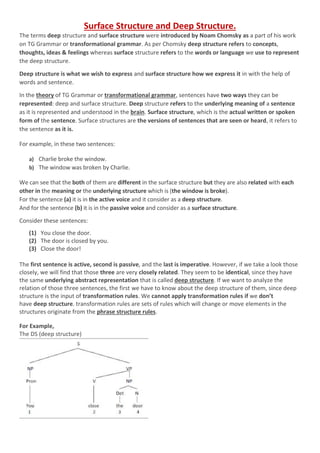Surface Structure and Deep Structure.docx
•
0 likes•73 views
Surface Structure and Deep Structure in Syntax
Report
Share
Report
Share

Recommended
More Related Content
Similar to Surface Structure and Deep Structure.docx
Similar to Surface Structure and Deep Structure.docx (20)
grammaticality, deep & surface structure, and ambiguity

grammaticality, deep & surface structure, and ambiguity
Recently uploaded
https://app.box.com/s/x7vf0j7xaxl2hlczxm3ny497y4yto33i80 ĐỀ THI THỬ TUYỂN SINH TIẾNG ANH VÀO 10 SỞ GD – ĐT THÀNH PHỐ HỒ CHÍ MINH NĂ...

80 ĐỀ THI THỬ TUYỂN SINH TIẾNG ANH VÀO 10 SỞ GD – ĐT THÀNH PHỐ HỒ CHÍ MINH NĂ...Nguyen Thanh Tu Collection
Recently uploaded (20)
Sensory_Experience_and_Emotional_Resonance_in_Gabriel_Okaras_The_Piano_and_Th...

Sensory_Experience_and_Emotional_Resonance_in_Gabriel_Okaras_The_Piano_and_Th...
Interdisciplinary_Insights_Data_Collection_Methods.pptx

Interdisciplinary_Insights_Data_Collection_Methods.pptx
NO1 Top Black Magic Specialist In Lahore Black magic In Pakistan Kala Ilam Ex...

NO1 Top Black Magic Specialist In Lahore Black magic In Pakistan Kala Ilam Ex...
dusjagr & nano talk on open tools for agriculture research and learning

dusjagr & nano talk on open tools for agriculture research and learning
HMCS Vancouver Pre-Deployment Brief - May 2024 (Web Version).pptx

HMCS Vancouver Pre-Deployment Brief - May 2024 (Web Version).pptx
Introduction to TechSoup’s Digital Marketing Services and Use Cases

Introduction to TechSoup’s Digital Marketing Services and Use Cases
80 ĐỀ THI THỬ TUYỂN SINH TIẾNG ANH VÀO 10 SỞ GD – ĐT THÀNH PHỐ HỒ CHÍ MINH NĂ...

80 ĐỀ THI THỬ TUYỂN SINH TIẾNG ANH VÀO 10 SỞ GD – ĐT THÀNH PHỐ HỒ CHÍ MINH NĂ...
Beyond_Borders_Understanding_Anime_and_Manga_Fandom_A_Comprehensive_Audience_...

Beyond_Borders_Understanding_Anime_and_Manga_Fandom_A_Comprehensive_Audience_...
Surface Structure and Deep Structure.docx
- 1. Surface Structure and Deep Structure. The terms deep structure and surface structure were introduced by Noam Chomsky as a part of his work on TG Grammar or transformational grammar. As per Chomsky deep structure refers to concepts, thoughts, ideas & feelings whereas surface structure refers to the words or language we use to represent the deep structure. Deep structure is what we wish to express and surface structure how we express it in with the help of words and sentence. In the theory of TG Grammar or transformational grammar, sentences have two ways they can be represented: deep and surface structure. Deep structure refers to the underlying meaning of a sentence as it is represented and understood in the brain. Surface structure, which is the actual written or spoken form of the sentence. Surface structures are the versions of sentences that are seen or heard, it refers to the sentence as it is. For example, in these two sentences: a) Charlie broke the window. b) The window was broken by Charlie. We can see that the both of them are different in the surface structure but they are also related with each other in the meaning or the underlying structure which is (the window is broke). For the sentence (a) it is in the active voice and it consider as a deep structure. And for the sentence (b) it is in the passive voice and consider as a surface structure. Consider these sentences: (1) You close the door. (2) The door is closed by you. (3) Close the door! The first sentence is active, second is passive, and the last is imperative. However, if we take a look those closely, we will find that those three are very closely related. They seem to be identical, since they have the same underlying abstract representation that is called deep structure. If we want to analyze the relation of those three sentences, the first we have to know about the deep structure of them, since deep structure is the input of transformation rules. We cannot apply transformation rules if we don’t have deep structure. transformation rules are sets of rules which will change or move elements in the structures originate from the phrase structure rules. For Example, The DS (deep structure)
- 2. From the above example, it can be decided that deep structure then is a pure representation of thematic relations. Anything which is interpreted as the subject or object of a given predicate will be in the subject or object position of that predicate at Deep structure no matter where it is found at Surface structure. (2) SD (structure description): SC (Structural change): SS (Surface structure): 1 2 3 4 3 4 + be verb + 2 + en 1 The door is closed by you Note: the SC is passive transformation rules (3) SD: SC: SS: 1 2 3 4 0 2 3 4 Close the door! Note: 0 is deletion